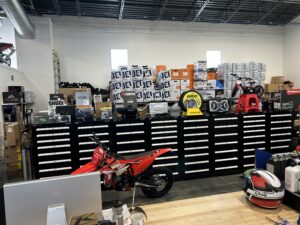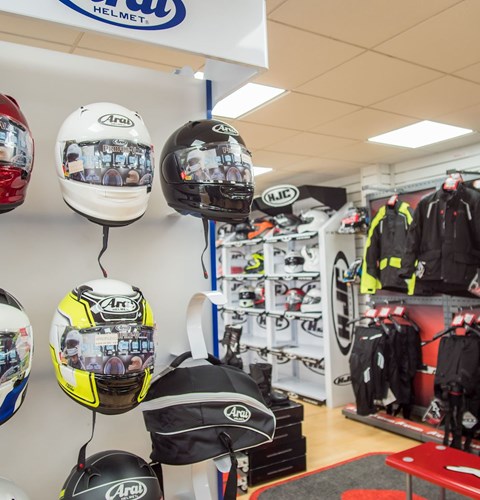Store the Best MX Parts NZ for Your High-Performance Bike
Store the Best MX Parts NZ for Your High-Performance Bike
Blog Article
Comprehending the Vital Parts of a Bike: A Comprehensive Guide for Fanatics
For motorcycle lovers looking to elevate their riding experience and guarantee their bikes run efficiently, comprehending the crucial elements of a motorbike is vital. Each element, from the engine's complex workings to the critical duty of the braking mechanisms, not just influences efficiency yet additionally safety and security and convenience.
Engine Components

The camshaft plays a vital role in regulating the timing of the engine's valves, ensuring the specific opening and closing required for reliable fuel and air consumption, as well as exhaust expulsion. This timing is critical to maintaining ideal engine performance and effectiveness. In addition, the carburetor or fuel injection system, relying on the motorbike version, is accountable for mixing air with gas in the correct proportion for burning.
The cooling system, either air or liquid-based, works to preserve the engine's temperature within functional limits, preventing getting too hot and ensuring long life - motocross gear. Each element, thoroughly developed and incorporated, adds to the seamless operation of the engine, specifying the bike's power result and overall performance
Transmission System
Essential to the motorbike's capability, the transmission system ensures efficient power transfer from the engine to the wheels. This system makes up a number of critical components, including the clutch, transmission, and last drive, each playing an important duty in equating the engine's power right into motion. The clutch, generally operated by a hand bar, serves to involve and disengage the engine from the transmission, permitting smooth gear adjustments and controlled acceleration.
The transmission, frequently described as the transmission correct, contains a set of gears that bikers can manually shift via to adjust the bike's speed and torque output. These equipments are arranged in a series that allows the motorbike to speed up smoothly and maintain optimum engine efficiency throughout different speeds. Many motorcycles utilize a sequential gearbox, requiring the motorcyclist to move gears in a predetermined order.
Braking Devices
While recognizing the transmission system is vital to using a motorbike's power, similarly important is the capacity to manage and stop that power efficiently, which is where braking devices come right into play. Brakes are critical for safety and security and performance, giving the motorcyclist with the required control to browse different terrains and problems. Typically, bikes feature two kinds of braking systems: disc brakes and drum brakes.
Disc brakes are much more widespread in modern-day motorbikes due to their premium efficiency. This system offers better heat dissipation, consistent efficiency, and improved quiting power, particularly in damp problems.
Conversely, drum brakes, though less usual, are still discovered in some motorcycles. They work by pushing brake footwear against the inner surface of a drum connected to the wheel. While usually less effective in warm dissipation and quiting power, drum brakes are simpler and much more cost-effective.
Recognizing these stopping systems' subtleties allows cyclists to maintain their motorcycles effectively and appreciate the design that guarantees reliable and risk-free quiting.
Suspension and Steering
Suspension and steering systems are essential elements that significantly influence a motorbike's handling and ride convenience. The shock absorber, containing forks at the front and shock absorbers at the rear, takes in roadway irregularities, improving stability and control. Front forks, inverted or typically telescopic, look at this web-site compress and rebound to mitigate impacts, while back shock absorbers keep tire call with the road, important for grip and security.
Steering, centered around the handlebars, connects the cyclist to the bike's directional control. The guiding head bearings make sure smooth operation, permitting exact ability to move. Proper alignment and maintenance of these bearings are critical for predictable guiding feedback and reducing biker tiredness.
The suspension's adjustability is another crucial aspect; preload, damping, and rebound setups enable customization to suit numerous riding designs and problems. This adaptability is necessary for maximizing efficiency, whether navigating urban streets or tackling sturdy trails. Technologies like digital shock absorber supply real-time modifications, enhancing adventure high quality across varied terrains.

Electric Systems
After making certain a smooth and regulated trip through reliable suspension and steering systems, attention turns to the electrical systems, a pivotal element of modern bikes. These systems pink dirt bike gear play an important duty not only in beginning the engine but likewise in powering various parts that improve the functionality and safety and security of the bike.
At the heart of a bike's electrical system is the check here battery, which stores electric energy necessary for beginning the engine and powering supporting systems - mx parts nz. The alternator or generator, coupled with the rectifier-regulator, guarantees the battery remains charged while the motorcycle is in operation, converting mechanical power into electric power and keeping voltage degrees
The ignition system, another essential part, is liable for sparking the air-fuel blend in the engine's cylinders. Modern bikes usually utilize an electronic ignition system, providing higher performance and integrity contrasted to typical systems.
Lighting systems, consisting of headlights, tail lights, and indicators, are also crucial, ensuring exposure and safety and security for the rider. Additional electronic elements such as sensing units, control units, and shows add to advanced features like gas injection management, anti-lock braking systems (ABDOMINAL MUSCLE), and digital control panels, additionally enhancing the riding experience.
Final Thought
A detailed understanding of a bike's vital components, including the engine, transmission system, stopping systems, suspension, steering, and electrical systems, is important for enthusiasts intending to enhance safety and security, convenience, and performance. Proficiency of these elements enables educated decisions concerning upkeep and upgrades, ultimately boosting the riding experience. By incorporating this understanding, motorcyclists can guarantee their motorcycles operate at peak efficiency and dependability, thus optimizing both enjoyment and longevity of their lorries.
For motorcycle fanatics looking to elevate their riding experience and ensure their bikes run smoothly, comprehending the essential elements of a motorbike is extremely important.Essential to the motorbike's functionality, the transmission system makes sure effective power transfer from the engine to the wheels.While recognizing the transmission system is vital to harnessing a motorbike's power, just as essential is the capacity to control and quit that power properly, which is where stopping systems come into play. Typically, motorbikes include two types of braking systems: disc brakes and drum brakes.
An extensive understanding of a bike's vital components, including the engine, transmission system, braking systems, suspension, guiding, and electrical systems, is vital for lovers aiming to enhance efficiency, comfort, and security.
Report this page